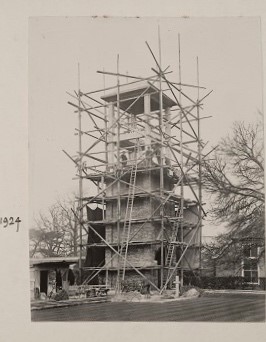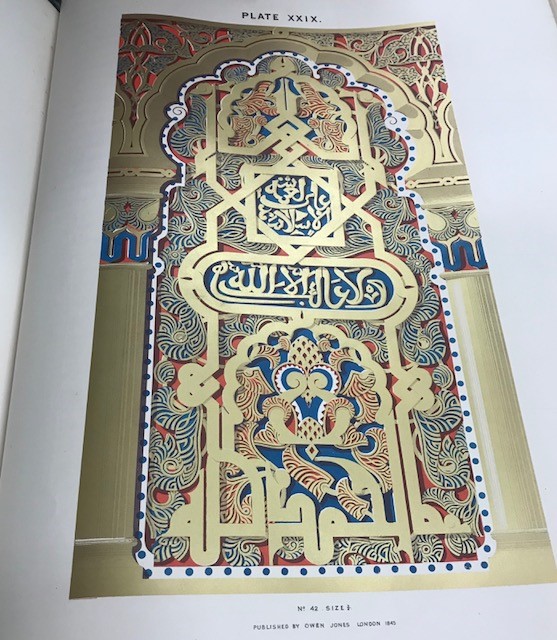Written by Anna Murdoch, Graduate Trainee Library Assistant.
You never quite know what you could find browsing the shelves in the rare book store, and how you could reach into the archives of both Special Collections and the MERL to find connections to a particular work. As a former English Literature student, I particularly enjoy the Reserve, the general rare books collection. Not everything has been catalogued yet so you could find an unknown gem sitting pretty, or plainly, on the shelf. Having done research into publications by lesbian and bisexual women, certain books were going to draw my eye. Last autumn, I discovered one such book.
A hidden gem

The unassuming blue cloth cover of Despised & Rejected
Despised & Rejected is a novel set amongst pacifists during World War I. It was published in 1918 under a pseudonym – A.T. Fitzroy – by Rose Allatini. Allatini was a young female author who had been published by Mills & Boon, and Allen & Unwin. In the case of Despised & Rejected a less high-profile publisher (at least in our contemporary consciousness) appears on the title page and the spine, unassumingly covered in blue cloth: C.W. Daniel.
An exciting moment came upon opening the book. The front endpaper is adorned with nothing less than the bookplate of Lytton Strachey, writer, critic and member of the Bloomsbury set.

The bookplate of Lytton Strachey found in the Special Collections copy of Despised & Rejected.
This in itself is pretty fascinating, proof of his, a gay man’s, ownership of a book with gay and lesbian characters. He has signed the front free endpaper, dating it with what I assume to be the month he read it. In pencil he has added an address: “The Mill House, Tidmarsh, Pangbourne, Berks”. This is famous as the location rented by Strachey and artist Dora Carrington and as place where they were visited by other figures of interest during LGBT history month: Duncan Grant and John Maynard Keynes.

A photograph of Tidmarsh Village taken by Philip Collier in the early 20th century.
‘Ishmaelites’ at Allen & Unwin
The story of how C.W. Daniel came to publish this novel can be traced in the archives of Allen & Unwin here at the University of Reading. Allatini had hoped to publish with them a second time as they had published her well-received Root and Branch in 1917.
The sequence of events began in the August of 1917 when Allatini sent in her manuscript provisionally entitled “Ismaelites”. She expressed to Mr. Reynolds, a solicitor hired by the company to act as secretary, she hopes it will find favour in his sight.
The next date of significance is that of Bernard Miall’s reader’s report, later in August. At five pages, full of comically outrageous expressions, it is quite a read. Miall opines that “music does not stimulate sex – except in Germans” and that “if Russian women can fight Germans surely sexual perverts can”. He feared that the “effect [of her work] will not be pleasant; the average female reader will ever after be filled with hectic jealousy of her fiancé’s or husband’s male friends”.
Publishers at the time were under the shadow of the Defence of the Realm Act (D.O.R.A.) and this is obvious reading Miall’s report. He wonders if the military censor reads novels and condemns Allatini – not for making her central character, Dennis, a pacifist, but an “illogical pacifist”. Additional condemnation is expressed for mixing up two subjects “both unpopular, and both under an official ban”. Dennis bears the brunt of Miall’s critique, but Antoinette, the central female character, is subject to a different angle of aggression. Miall espouses the idea that “once she has been subjected to a certain amount of masculine love-making, [she] becomes normal”. He describes Antoinette as having a “schoolgirl infatuation” and that “nine times out of ten it [same-sex desire] is due simply to immaturity and repression”. This recalls the contemporary concern about the school as a single-sex environment: that they were unhealthy and didn’t adequately enforce what we would now label ‘compulsory heterosexuality’. Yet Miall, towards the end, writes “it is too good to lose if you can publish it. Can you?” No, was the strong and firm message from higher authorities. Edgar L. Skinner, who was out on war service, read the manuscript and wrote in early October that he had
no hesitation in saying that if in a moment of madness you were to publish it, you would most certainly find yourself in Bow St [magistrates’ court]. I have seldom read anything so crudely improper.
He ended by begging them to “pray therefore return it hastily lest worse befall you”.
Stanley Unwin, in The Truth about a Publisher touches very briefly upon this episode. Unwin writes that C.A. Reynolds had indicated to the “authoress” (Allatini is unnamed) that they would be receptive to publishing her manuscript and he would therefore feel sorry having to deny her. Reynolds asked for a publisher to redirect her to. Unwin writes he expressed that, due to the subjects involved, the only name he had to suggest was that of C.W. Daniel. Daniel had already been prosecuted under D.O.R.A. for his own pamphlet which attacked Lloyd-George’s war policy.
In the correspondence found in the archive both Unwin and Reynolds kept their opinions on ‘Ishmaelites’ closely held. Reynolds only expressed that he believed the police would find Marie Stopes’ Married Love more objectionable in comparison. Indeed, the only critique one can find is the “geographical and topographical eccentricities” Unwin wrote to Allatini about in September. Later that month, they arranged to meet in person to discuss coming to a “mutually satisfying arrangement” regarding her manuscript. Nothing is to be seen of these discussions, or of the personal impression of her work that she sought from him in early October. Sadly, they do not wend their way into the letters.
Although it was clear Allen & Unwin would not be publishing her work Allatini continued to write to them until the end of the year. In early December she wrote that Edward Carpenter was coming to town on about the 18th. Carpenter was an activist for the rights of homosexuals, was himself gay, and someone Allatini consulted about her manuscript whilst he was in London.
Despised & rejected at C.W. Daniel
At the end of December, Allatini wrote to Mr Unwin that as a result of a “terrific upheaval” within her family, who she described as “very military + narrow-minded”, she would have to publish under a pseudonym due to her economic dependence upon them. By this point, her contact with C.W. Daniel had been established and she described Mr Daniel as “very much distressed” that he would be unable to use the positive publicity generated from Root and Branch. She mentions Edward Carpenter in this letter and she conveyed to Unwin that he believed it a good enough work to attract attention on its own merits and the unknown element would not make much difference. Allatini did confess to seeing the merits of a pseudonym if the book were a failure, or, she writes with foresight “suppressed by the police”.
C.W. Daniel advertised the new publication as being a “vigorous and original story” dealing well with both conscientious objectors and “so-called Uranians whose domestic attachments are more in the way of friendship than of ordinary marriage”. Subsequent advertisements used quotations from the Times Literary Supplement identifying the author’s sympathy as “plainly with the pacifists” and “her plea for more tolerant recognition of the fact that some people are, not of choice but by nature, abnormal in their affections is open and bold enough to rob the book of unpleasant suggestion”.
The Saturday Review published a brief, punchy review of Despised & Rejected on the 6th of July 1918. The reviewer proclaims that “the author’s standpoint is pitifully repellent. Her defence of homosexual feeling is based on misunderstanding [sic] of Edward Carpenter”, but states she has “power of observation and description” and that with “experience, and more love and respect for ordinary people the author may do well”. The mention of Carpenter is rather hilarious with the knowledge gleaned from the archives that he had already read the work himself and, in a fashion, given it his seal of approval.
As Allatini and Allen & Unwin foresaw, legal trouble did follow the publication of the book. The Times reports the day after a court appearance that C.W. Daniel and a director Charles William Daniel were
summoned for making statements in a book entitled ‘Despised and Rejected’ likely to prejudice the recruiting, training, and discipline of persons in his Majesty’s forces, and for having 234 copies in their possession
It seems the argument offered by the defence was that it was “a novel, not a tract or a pamphlet”. The question of obscenity was not being prosecuted but Alderman Sir Charles Wakefield described the book as “morally unhealthy and most pernicious”. This echoes the words of James Douglas, infamous for his earlier attacks on D.H. Lawrence’s The Rainbow and later Radclyffe Hall’s The Well of Loneliness.
The defence did not prevail and Daniel was ordered to pay £460 in fines and court costs. Interestingly, Stanley Unwin contributed to the fund because he felt guilt for having enabled the publication. Daniel published a pamphlet after the legal troubles subsided proclaiming that he had not been aware the book contained such “depravity” and he would rather have a book burnt than “be party to lending support” to homosexuals. This claim may be believable to some but taking into consideration every individual who is documented to have read the manuscript was aware of the content it strains credulity. Taking the pre-publication advertisements into account stresses this even further.
Daniel had only printed 1,012 copies of Despised & Rejected. After the prosecution, in October 2018, 234 copies were seized, leaving 778 in circulation. Fortunately, the copy that now resides in the University of Reading’s Special Collections was formerly owned by Lytton Strachey, a gay conscientious objector and was therefore, one would think, at very little risk. The book found its way to the library at the University of Reading in roughly the late sixties after being donated by Lytton Strachey’s sister-in-law, the psychoanalyst Alix Strachey.
References:
‘C.W. DANIEL’, The Times Literary Supplement, (London, England),Thursday, May 09, 1918; pg. 221; Issue 851.
‘Despised & Rejected’, The Times Literary Supplement, (London, England), Thursday, May 23, 1918; pg. 239; Issue 853.
‘Despised and Rejected’, The Times Literary Supplement, (London, England),Thursday, June 20, 1918; pg. 286; Issue 857.
‘Despised And Rejected’, The Times, (London, England), Friday, Oct 11, 1918; pg. 5; Issue 41918.
Fitzroy, A.T., Despised and rejected, London: C.W. Daniel, [1918] – Reserve—821.912-ALL, University of Reading Special Collections.
Parker, Peter, ‘Differently decent’, The Times Literary Supplement, (London, England), Friday, August 19, 1988; pg. 916; Issue 4455.
Rich, Adrienne, ‘Compulsory Heterosexuality and Lesbian Existence’, Signs, Vol. 5, No. 4, Women: Sex and Sexuality (Summer, 1980), 631 – 660.
Simmer, George, ‘C.W. Daniel, radical publisher’, Great War Fiction, (https://greatwarfiction.wordpress.com/2015/02/12/c-w-daniel-radical-publisher/), [accessed 16th January 2019].
‘The Mill at Tidmarsh: bohemian days leave a rich legacy’, The Telegraph, 18th June 2010,
(https://www.telegraph.co.uk/finance/property/period-property/7827396/The-Mill-at-Tidmarsh-bohemian-days-leave-a-rich-legacy.html) [accessed 16th January 2019].
‘Tidmarsh Village (2906)’, P DX323 PH1/E191/4, Philip Osborne Collier Photographic Collection, The Museum of English Rural Life.






























 correspondence, ledgers & miscellaneous records from 1813–1976. The
correspondence, ledgers & miscellaneous records from 1813–1976. The 














